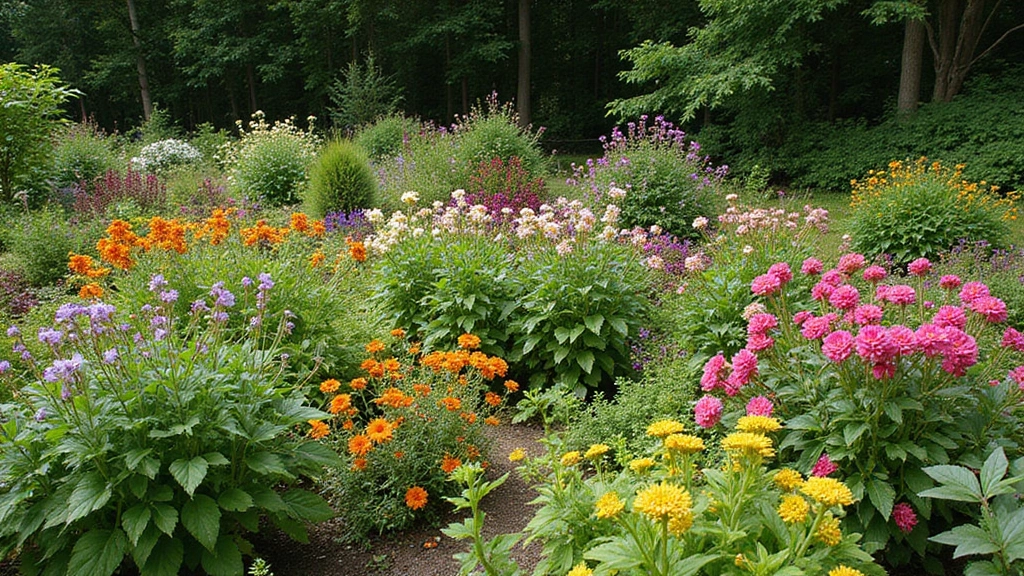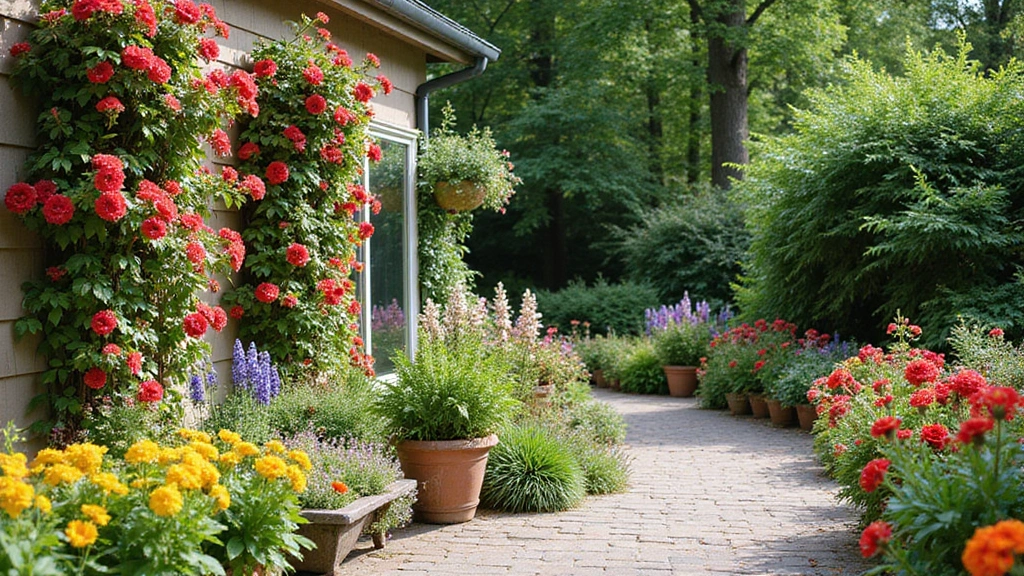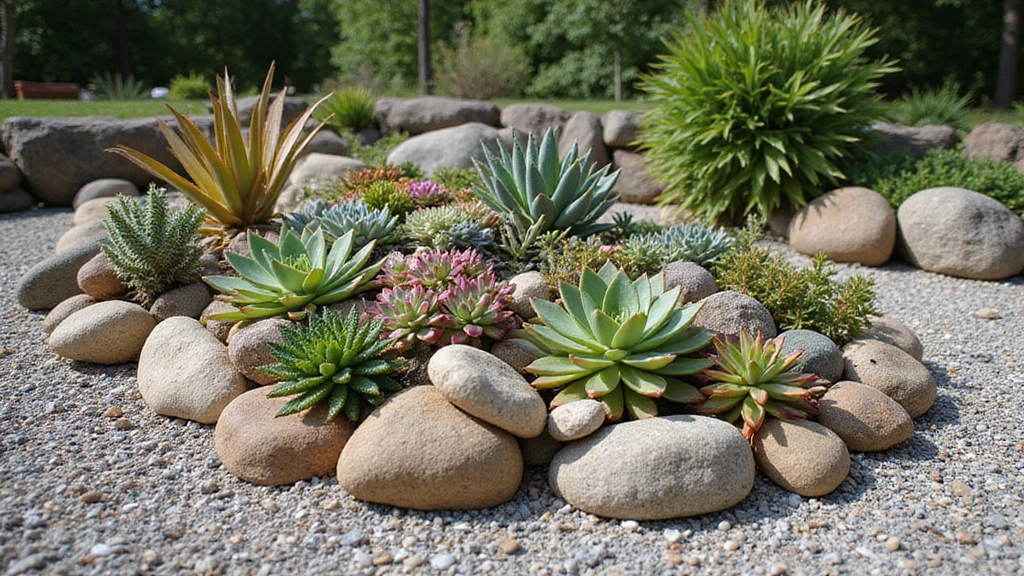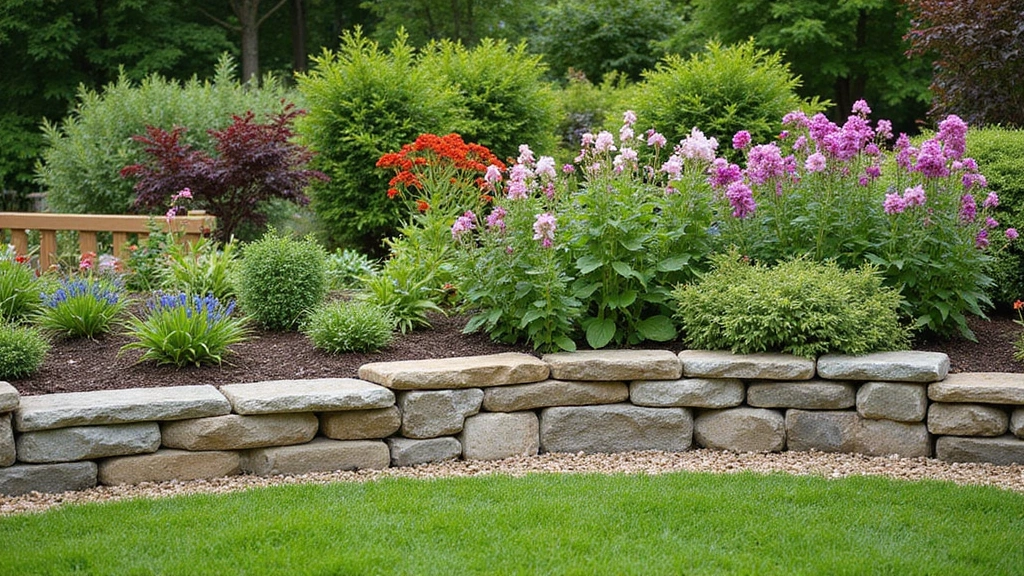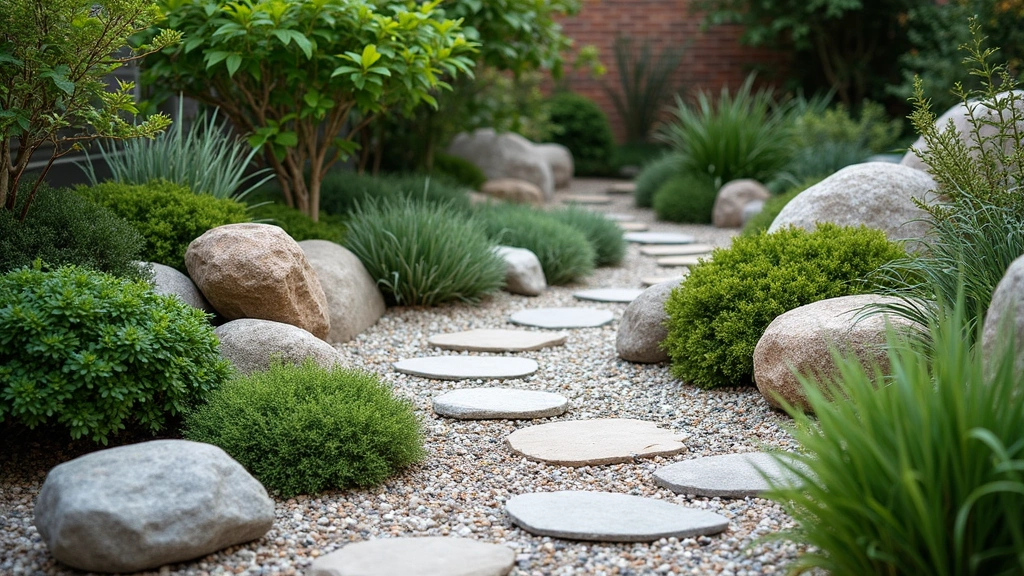Creating a vibrant, thriving garden that blooms all year round is an exciting adventure for any gardening enthusiast. Perennial plants offer a fantastic way to ensure your garden is bursting with color, even in the shaded areas. Investing in the right combination of shade-tolerant perennial plants can transform a dull corner into a lively sanctuary filled with texture and hues that change with the seasons. Low-maintenance gardening can be both beautiful and simple, allowing time to enjoy your space rather than constantly tending to it. From delicate pastels to bold jewel tones, here are 25 inspiring perennial garden ideas that can breathe life into your shaded areas throughout the year.
1. Hostas: The Versatile Foliage
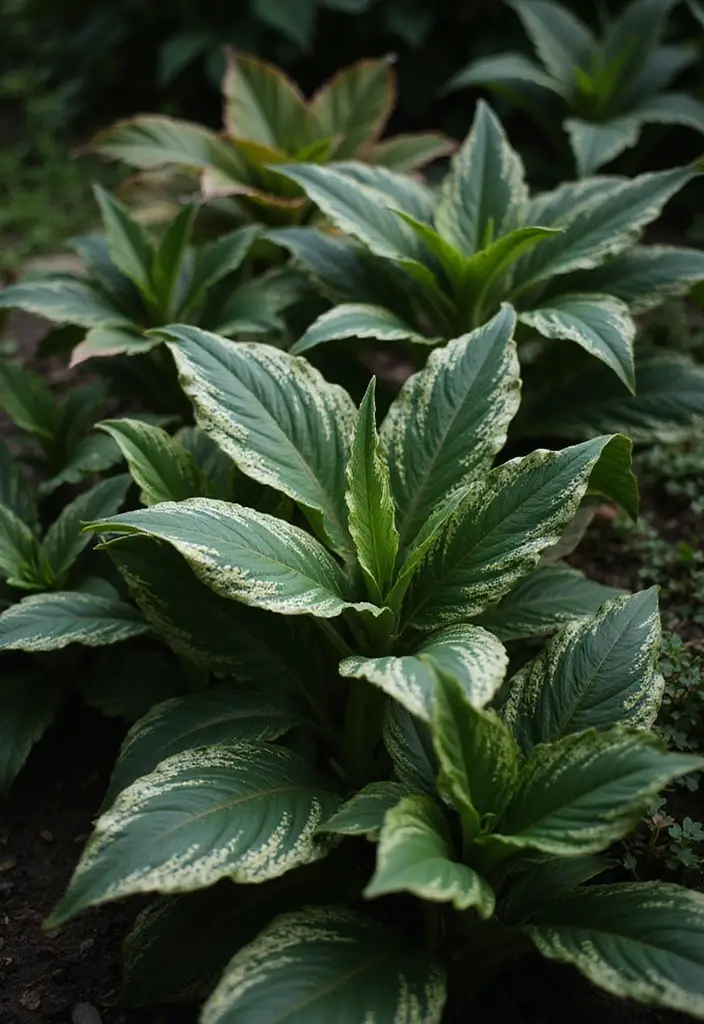
Hostas are the champions of shade gardens, boasting broad leaves that come in a range of colors from deep green to pale blue and even variegated forms. Their foliage provides a stunning backdrop for any garden design, and their flowers—white or lavender—add a lovely touch in summer. To keep your hostas thriving, consider using organic mulch. This will help maintain soil moisture, creating an ideal environment for these beautiful plants. Mixing different varieties can achieve a layered look, and placing them near pathways or seating areas allows you to enjoy their delightful scent, especially since some hostas are even fragrant. Additionally, a garden watering can is essential for keeping them well-watered, ensuring they flourish throughout the growing season. For an added touch, consider the hosta plant for a faux green addition that provides everlasting beauty in your garden design without the maintenance.
2. Astilbe: Colorful Plumes
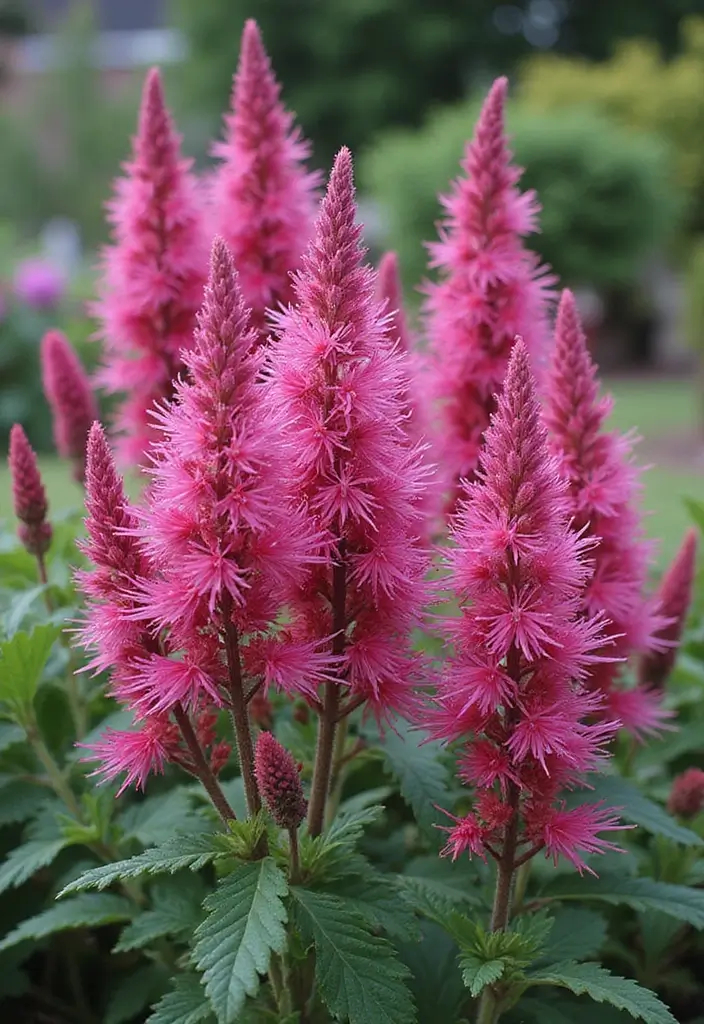
Astilbe brings a burst of color and texture to any shaded garden with their feathery plumes. These perennials thrive in moist soil and prefer partial to full shade, making them ideal for those tricky corners of your garden. They bloom in shades of pink, red, white, and purple, providing a striking contrast against the green foliage. To create a dramatic impact, group them in clusters.
To ensure that your Astilbe flourish, it’s important to start with rich soil. Using a premium organic mulch can help retain moisture and keep the area well-mulched, which is crucial for these thirsty plants. Additionally, it can be beneficial to understand your soil’s composition. A soil test kit allows you to accurately measure pH and nutrient levels, ensuring your Astilbe have everything they need to thrive.
Astilbe’s blooms can last for weeks, making them a fantastic choice for cut flower arrangements, too! Consider adding the Astilbe arendsii ‘Fanal’, featuring deep red flowers that will complement any garden setting beautifully. By taking care of these details, you can enjoy vibrant blooms and a lush garden year-round.
3. Bleeding Heart: Romantic Charm
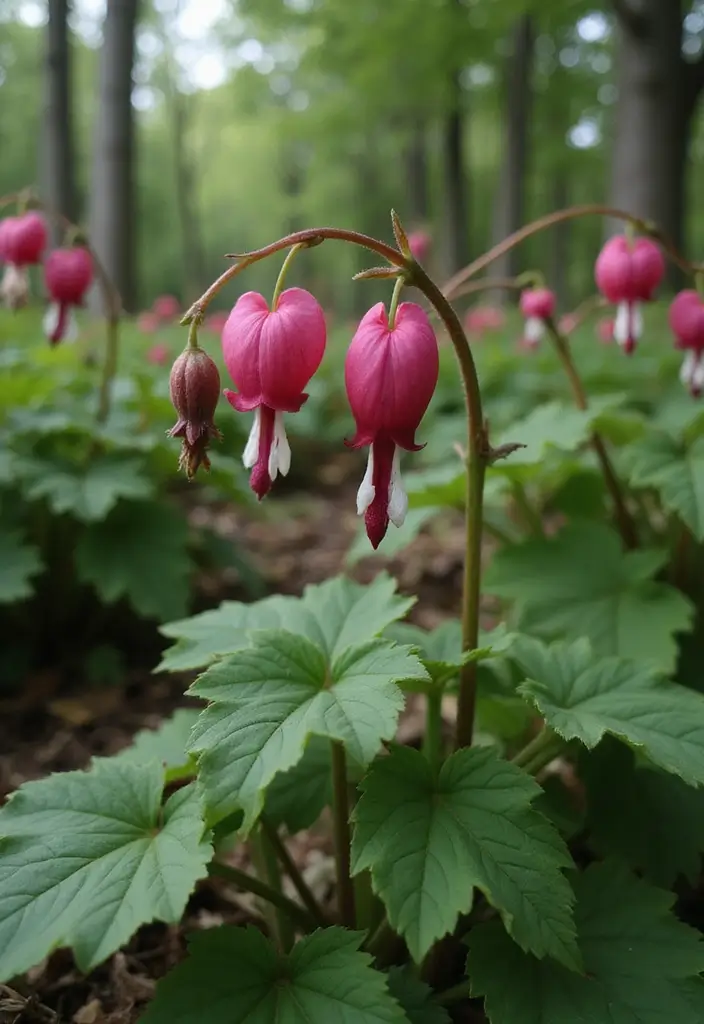
Bleeding hearts are enchanting plants, known for their unique heart-shaped flowers that dangle gracefully from arching stems. These perennials thrive in partial shade and bloom in lovely shades of pink and white, creating a dreamy atmosphere in your garden. To ensure your bleeding hearts flourish, consider using organic potting soil, which provides rich, moisture-retentive conditions that help keep their blooms vibrant. Additionally, a garden mulch can be beneficial as it conserves water and suppresses weeds, allowing your plants to focus their energy on growth.
It’s also important to provide them with adequate watering, and a soaker hose can make this task easier by delivering water directly to the roots while saving water. Remember that these plants die back in the summer, so it’s wise to plant them near other perennials that bloom later to fill in the gaps and maintain a vibrant garden throughout the seasons.
4. Japanese Forest Grass: A Textural Delight
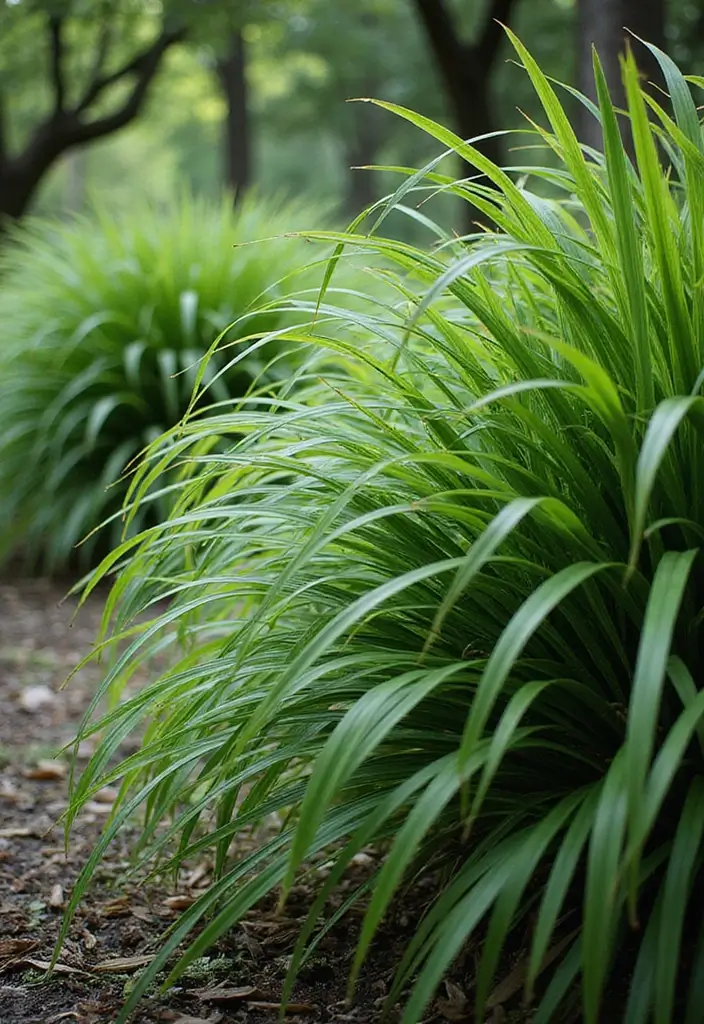
Japanese Forest Grass (Hakonechloa macra) is a stunning ornamental grass that thrives in shade. Its graceful arching habit and vibrant green or golden foliage bring movement and a soft texture to your garden. To enhance its growth and ensure it thrives, consider using Burpee, 9 Quarts | premium organic potting natural soil mix. This soil mix is ideal for container gardens and provides the essential nutrients that help Japanese Forest Grass flourish.
Additionally, using Back to the Roots 25.7qt organic premium mulch can help retain moisture in the soil and regulate temperature, creating the perfect conditions for your grass to thrive, especially in shaded areas. This grass can provide a beautiful contrast when paired with sturdier perennials like hostas or astilbes, so consider planting it alongside these varieties for added visual interest.
For those who prefer propagation, All Gold Japanese Forest Grass seeds are a great option to consider. This way, you can cultivate your own plants while enjoying the vibrant foliage and texture they offer. Japanese Forest Grass requires minimal maintenance, making it a perfect choice for a low-effort yet visually appealing garden design.
5. Coral Bells: Colorful Foliage
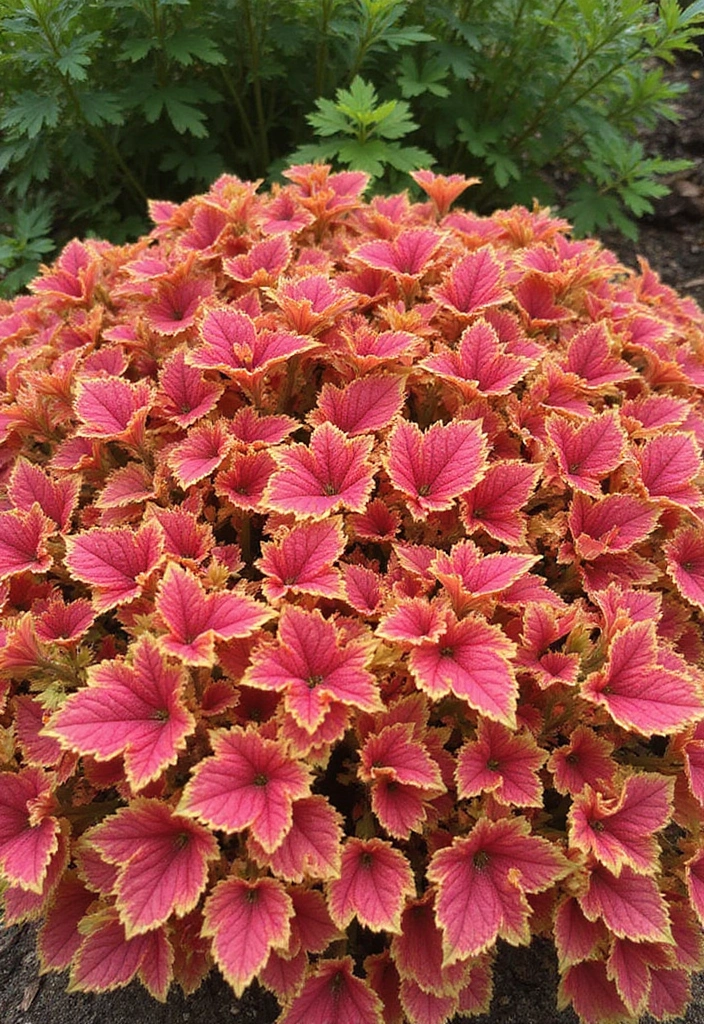
Coral bells, or Heuchera, are known for their stunning, colorful foliage that ranges from deep burgundy to lime green. These low-maintenance perennials thrive in shady spots and add a splash of color even when not in bloom. Their delicate flowers bloom on tall spikes during the summer, attracting hummingbirds and butterflies. To ensure your coral bells flourish, consider using Miracle-Gro Shake ‘N Feed All Purpose Plant Food to provide vital nutrients for up to three months, promoting healthy growth and vibrant colors.
Additionally, planting your coral bells in clusters will enhance their visual impact and create beautiful contrasts with other plants. To help retain moisture and suppress weeds around your coral bells, you might want to apply organic mulch for garden beds. This premium mulch not only enriches the soil but also helps maintain the right moisture levels for your plants.
Finally, once established, coral bells can tolerate drought, making them a resilient choice for your garden. To ensure you have strong, healthy plants, consider starting with Coral Bells (Heuchera) Plants like Heuchera ‘Black Sea’, which offers dark purple foliage that adds richness to your garden design. Enjoy the year-round beauty these versatile plants bring to your outdoor space!
6. Lungwort: The Early Bloomer
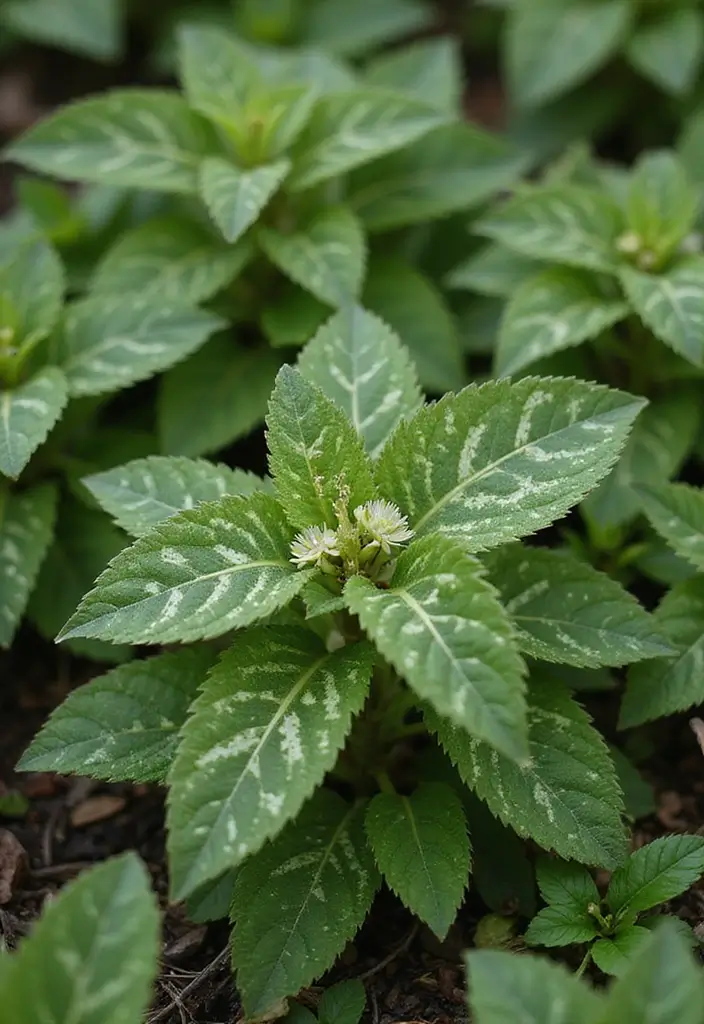
Lungwort, or Pulmonaria, is an excellent choice for early spring blooms. With speckled leaves and bright blue, pink, or white flowers, it brings early color to your garden before other perennials wake up. Lungwort thrives in moist, shady environments and is relatively low-maintenance. To ensure your lungwort and other plants receive the right amount of moisture, consider using the soil moisture meter. This handy tool allows you to monitor the moisture levels in your soil, helping you provide optimal care for your garden.
Additionally, remember to divide your lungwort plants every few years to maintain their vigor. Pairing them with ferns can create a lush look in your garden. To nourish your plants effectively, you might want to try organic fertilizer for perennials. This all-purpose plant food supports healthy growth for not only lungwort but also a variety of flowers, vegetables, and shrubs.
Finally, while tending to your garden, consider using a garden kneeler and seat. This multifunctional tool will make it more comfortable to work in your garden, especially in those moist, shady spots where lungwort thrives. The combination of these tools will help you maintain a vibrant and healthy garden, full of life year-round. Plus, the leaves of lungwort are said to have medicinal properties, making it a traditional favorite in many gardens.
7. Ferns: The Classic Shade Plant
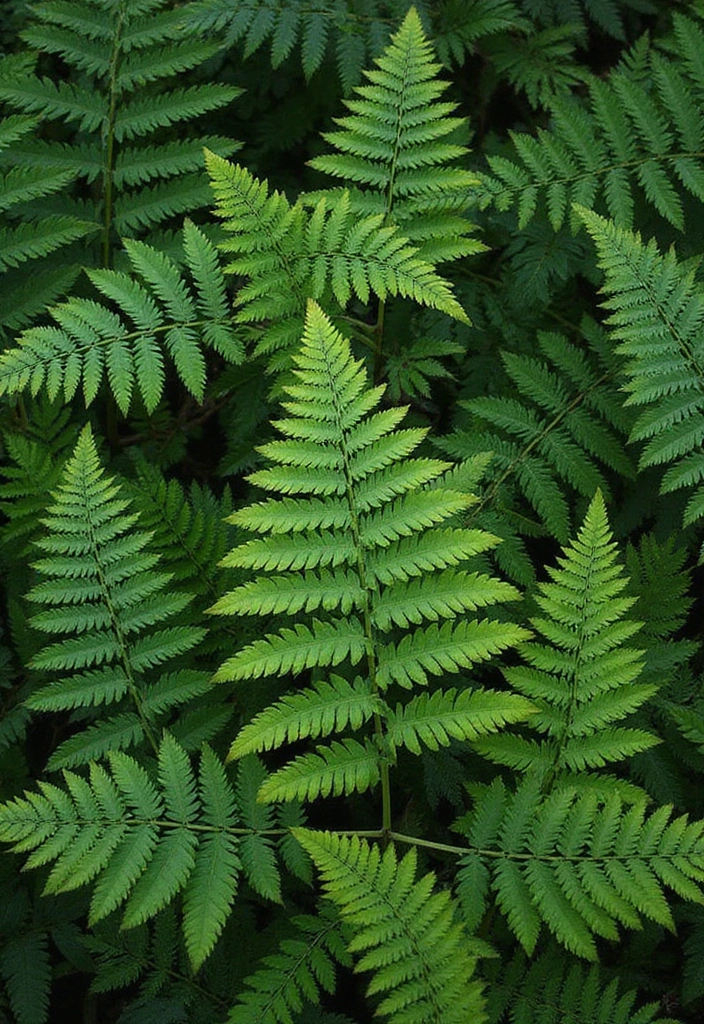
Ferns are an excellent choice for creating a lush, green backdrop in a shaded garden. They come in various species, each offering unique textures and forms. From the delicate maidenhair fern to the robust ostrich fern, these plants add depth and softness to your landscape. To ensure your ferns thrive, it’s crucial to provide them with adequate moisture and organic matter in the soil. A great option for this is Miracle-Gro Organic Outdoor Potting Mix, which contains quick-release natural fertilizer and is perfect for enriching the soil for outdoor container plants.
Additionally, consider grouping different varieties of ferns together for a dynamic look. To keep your ferns well-hydrated, a garden watering can is essential, especially one with a long spout for precision watering. This will help you deliver the right amount of moisture directly to the roots.
For optimal growth, using a suitable fertilizer is key. TPS NUTRIENTS Fern Fertilizer is specifically designed for all ferns and mosses, ensuring they receive the nutrients they need to flourish. Ferns can thrive in almost any condition, making them a resilient and versatile choice for gardeners.
8. Pulmonaria: Perfect for Pollinators
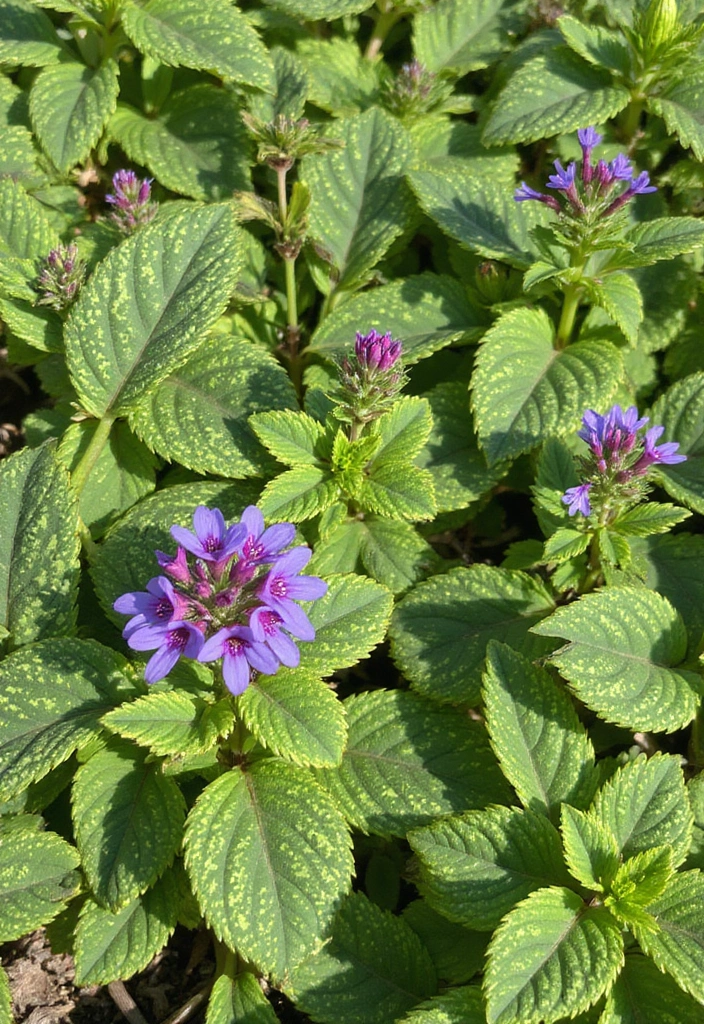
Pulmonaria, or lungwort, is a lovely perennial that thrives in shade. It’s praised for its beautiful, spotted leaves and clusters of small blue, pink, or white flowers that bloom in early spring. Not only is it a delight to the eye, but it’s also a magnet for early pollinators coming out after winter. To ensure that your pulmonaria thrives, consider using a garden soil moisture meter to monitor the moisture levels in your soil; this tool can help you maintain consistent moisture, which is essential for optimal growth. Additionally, applying a layer of organic mulch can retain moisture, suppress weeds, and provide nutrients as it breaks down, enhancing the overall beauty of your garden. With the right care, pulmonaria serves as a great ground cover, helping to beautify your space while attracting the important pollinators. For those looking to start from scratch, you can find pulmonaria seeds to grow your own delightful blooms!
9. Toad Lily: Exotic Appeal
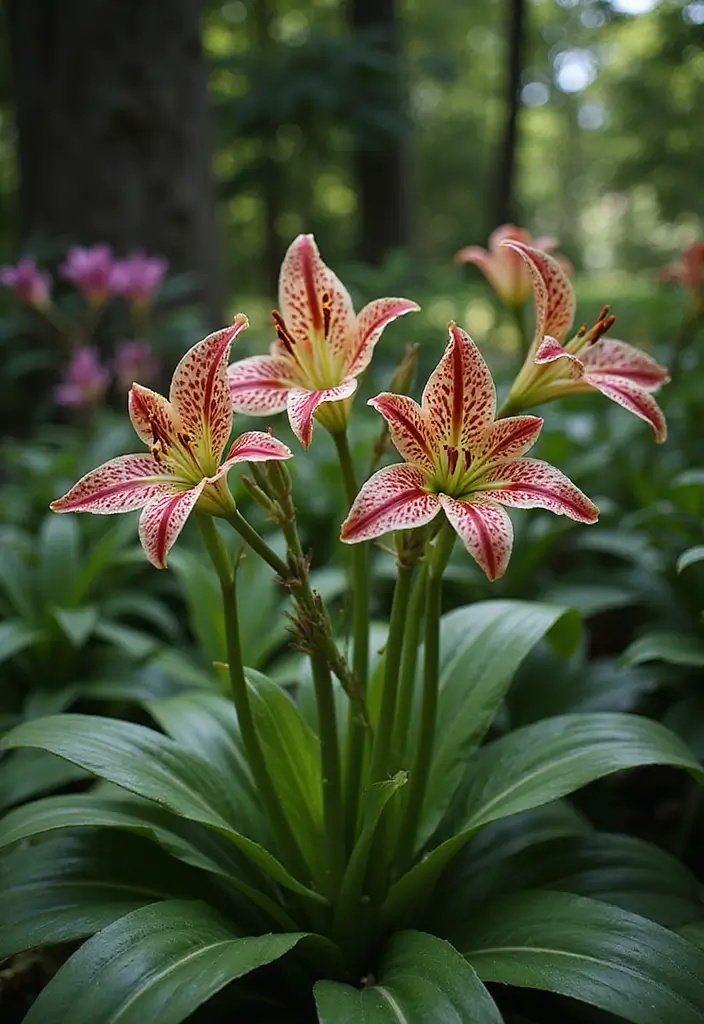
Toad lilies bring a touch of the exotic to your shaded garden with their unique, orchid-like flowers. These perennials thrive in both shade and partial sun, blooming in late summer to fall when many gardens are winding down. The intricate patterns on their petals add a mystical charm. To ensure your toad lilies flourish, consider using organic flowering plant fertilizer. This nutrient-rich food helps strengthen your plants, providing them with the essential elements they need to thrive.
They’re perfect for growing under trees or in shaded borders, and to keep the soil consistently moist, you might find a garden soil moisture meter invaluable. This handy device allows you to monitor the moisture levels, ensuring your toad lilies receive the right amount of water.
Additionally, toad lilies attract bees, making them a great addition for those looking to support local pollinators. You can further enhance this aspect of your garden with a bee-friendly wildflower seed mix. This mix not only provides beautiful blooms but also creates a welcoming environment for pollinators, promoting overall garden health.
10. Brunnera: Forget-Me-Not Alternative
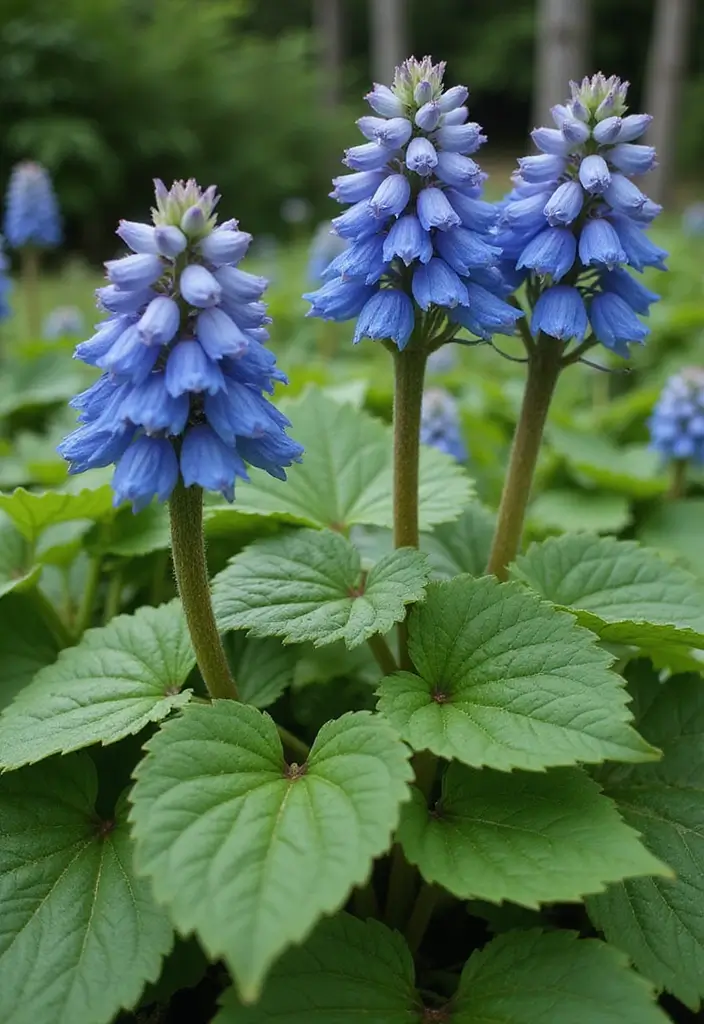
Brunnera, often referred to as Siberian bugloss, boasts heart-shaped leaves and beautiful clusters of tiny blue flowers that resemble forget-me-nots. This perennial thrives in shady spots and can handle different soil types, making it adaptable and easy to care for. To ensure your Brunnera remains healthy, it’s essential to keep the soil consistently moist, which can be easily monitored with a moisture meter for plants. This handy tool takes the guesswork out of watering, so you can maintain the ideal moisture level for your plants.
Applying mulch not only helps retain soil moisture but also prevents weed growth. Consider using organic mulch to provide your Brunnera with an extra layer of protection while enriching the soil over time.
Moreover, Brunnera’s foliage is attractive even when not in bloom, providing interest throughout the growing season. For those looking to start their Brunnera collection, Brunnera macrophylla seeds are a great way to begin your gardening journey, allowing you to enjoy this beautiful perennial in your own garden.
11. Sedum: A Touch of Succulence
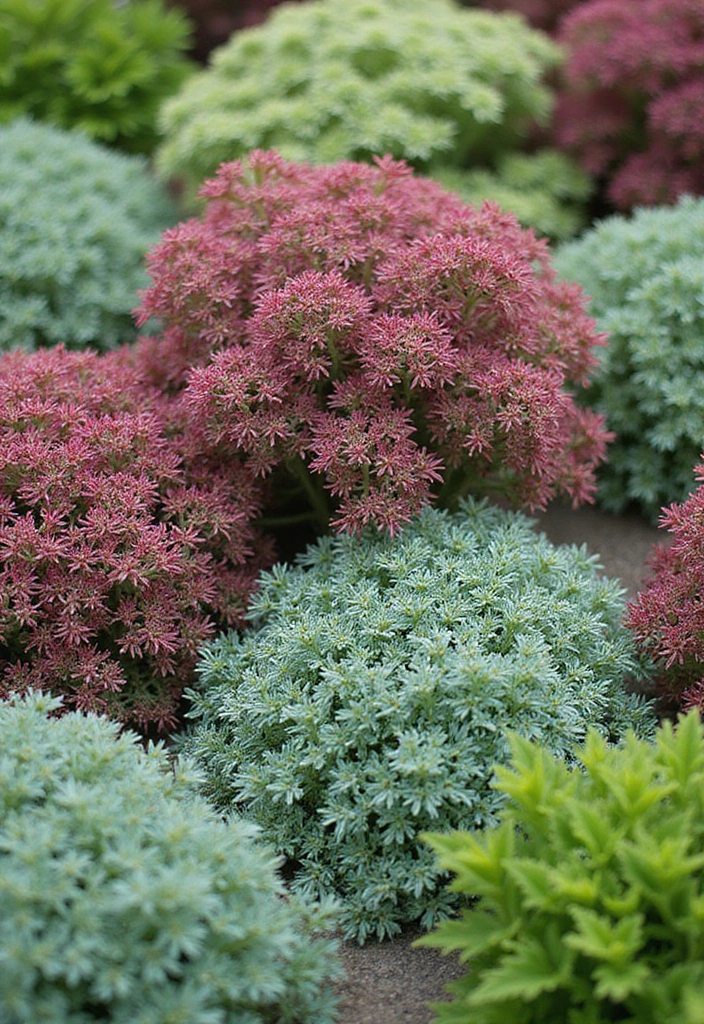
While many think sedum thrives in full sun, certain varieties are perfect for shadier spots. Their succulent leaves come in various hues, and they often produce colorful flowers in late summer. These hardy plants add interesting textures and colors to a shady garden. For instance, you can choose the Sedum ‘Autumn Joy’ plant, which not only brings vibrant pink flowers but also makes a stunning groundcover. If you prefer to start from seeds, the Sedum ‘Dragon’s Blood’ plant is an excellent choice, offering beautiful colors and the satisfaction of growing your own plants.
Additionally, investing in a solid gardening tool set can make planting and maintaining your sedums much easier. This durable set will equip you with the essential tools needed to create and care for your shady garden, ensuring that your plants thrive with minimal effort. Remember, sedums are drought-tolerant once established, making them a practical choice for low-maintenance gardening.
12. Siberian Iris: Graceful Blooms
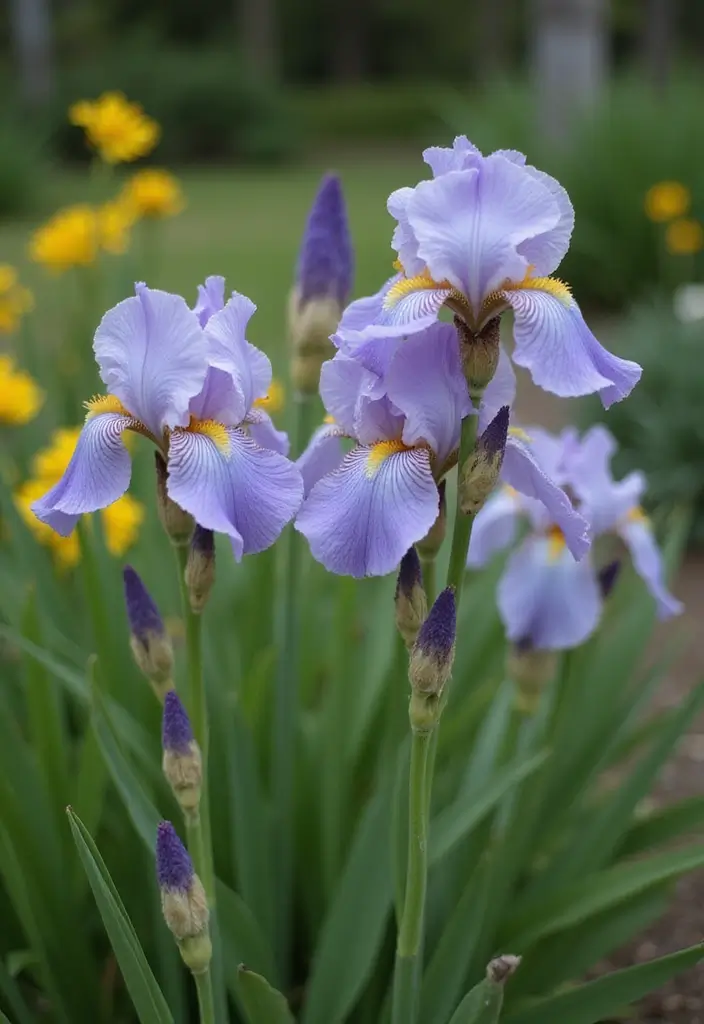
Siberian iris thrives in wetter soils and partial shade, making it an ideal candidate for those tricky low-light areas. Its elegant, sword-like leaves and stunning blue or purple flowers bloom in late spring to early summer. To ensure your Siberian iris flourishes, consider using a moisture meter for plants. This handy tool helps you monitor soil moisture levels, ensuring consistent hydration—essential for these moisture-loving beauties.
Additionally, incorporating organic mulch around your plants can significantly enhance moisture retention. Mulch not only keeps the roots of your Siberian iris comfortable but also suppresses weeds and adds a polished look to your garden. The foliage of Siberian iris can remain attractive even after blooming, providing structure to your garden throughout the year.
13. Epimedium: Ground Cover Wonder
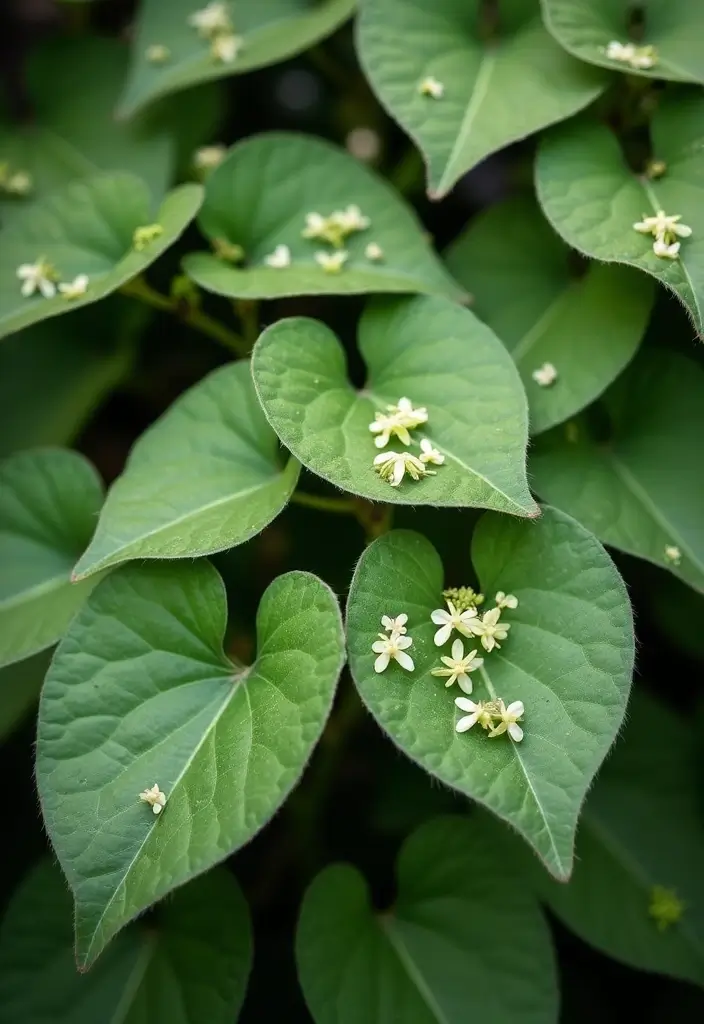
Epimedium, often called barrenwort, serves as an excellent ground cover for shaded areas. Its heart-shaped leaves provide a lush carpet, while delicate flowers bloom in spring. Epimedium is drought-resistant and can thrive in dry shade, making it an ideal choice for woodland gardens. To ensure your plants receive the optimal care, consider using a soil moisture meter. This handy device helps you monitor the moisture levels in the soil, ensuring your epimedium gets the right amount of water, especially in those dry conditions.
Additionally, adding a layer of organic mulch can help retain moisture and suppress weeds, allowing your epimedium to thrive. This perennial spreads slowly, so plant it where you want it to stay. Epimedium’s flowers attract pollinators, offering color and beauty to your garden while supporting wildlife.
14. Bellflower: Charming Clusters
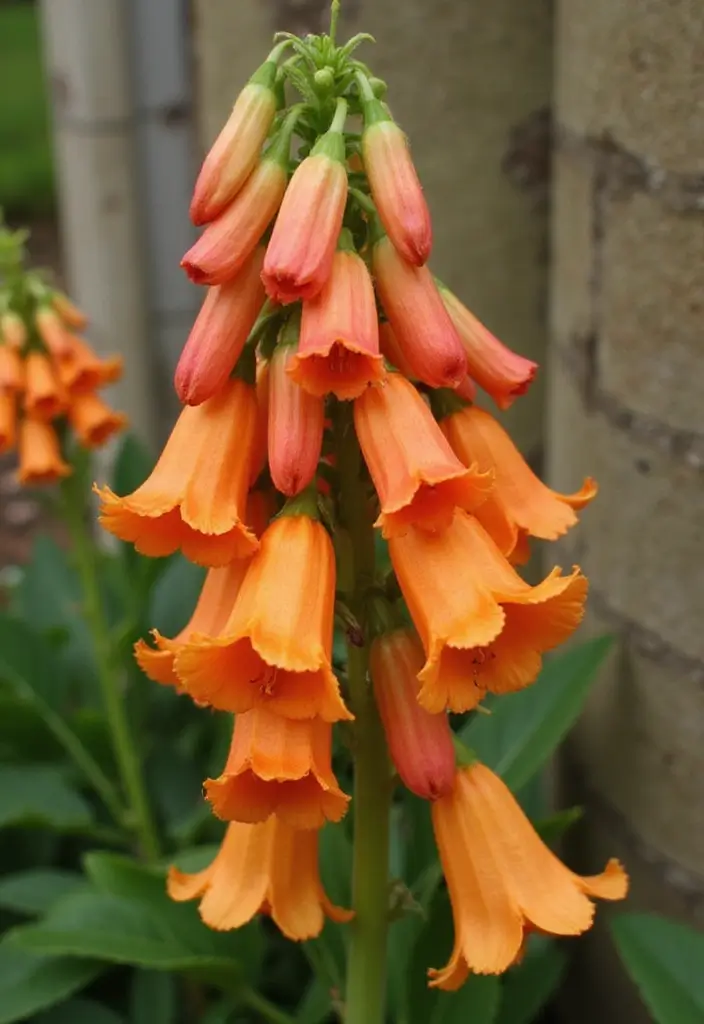
Bellflowers are perennial favorites known for their charming, bell-shaped blooms. They thrive in partial shade and can spread easily, filling empty spaces with their blue or purple flowers. To ensure your bellflowers flourish, consider using Organic Flower Fertilizer, which is specially formulated to provide essential nutrients for flowers, helping them to bloom vibrantly from late spring to early summer. Additionally, dividing the plants every few years will maintain their vigor and encourage lush growth.
For those looking to enhance their garden’s appeal to wildlife, bellflowers are also great for attracting bees and butterflies, making them a wonderful addition to pollinator gardens. To further support local pollinators, consider planting a mix of flowers with the Pollinator Garden Seed Mix. This blend contains 18 varieties of non-GMO flower seeds, encouraging a diverse and vibrant landscape.
For planting and maintaining your garden, a handy Garden Trowel Set will make digging and transplanting easier and more efficient. With these tools and plants, your perennial garden will thrive, coming alive with vibrant blue and purple hues while inviting the beauty of nature into your space.
15. Phlox: Sweet Fragrance
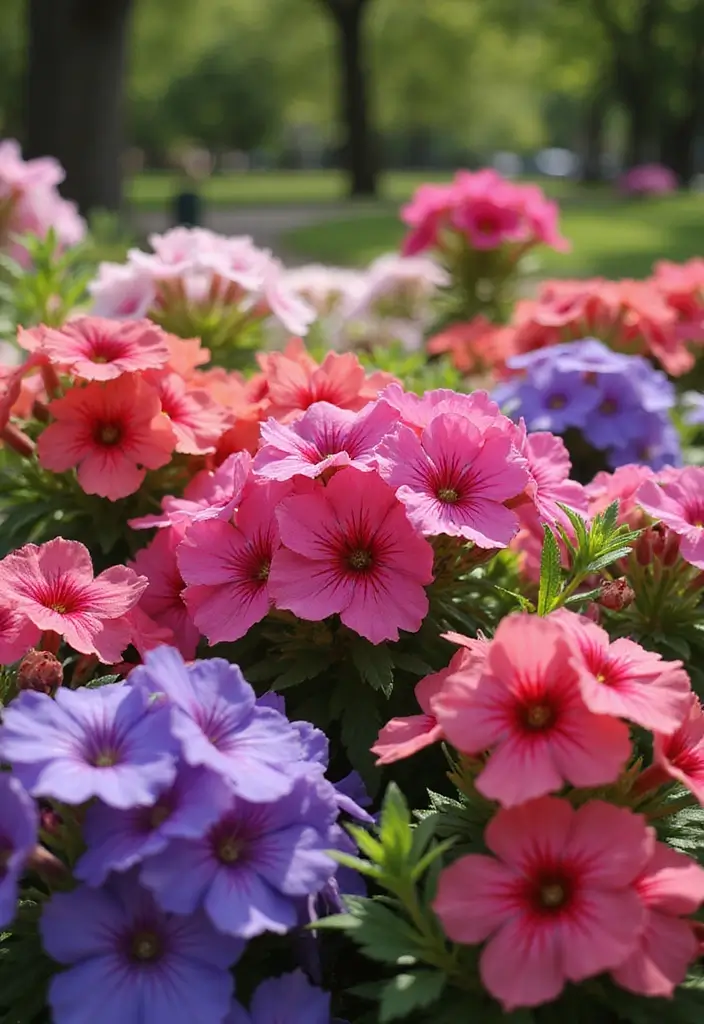
Phlox is a versatile perennial that thrives in light to partial shade, known for its sweet fragrance and vibrant flower clusters. Depending on the variety, they bloom from summer to fall, providing continuous color to your garden. The flowers come in an array of hues including pink, purple, and white. To achieve compact growth and better blooms, it’s beneficial to pinch back the stems early in the season. A great tool for this task is garden pruning shears, which feature a sharp, rust-resistant steel blade for precise cuts.
Additionally, to promote healthy growth and vibrant blooms, using a quality fertilizer can make a significant difference. Consider organic fertilizer for flowers, which is designed to nourish both annuals and perennials, ensuring your phlox thrive.
Another delightful aspect of phlox is that they attract butterflies, making your garden feel more lively and vibrant. For those looking to start their phlox collection, phlox plant seeds offer a fantastic way to introduce these charming blooms into your garden.
16. Columbine: Delicate Beauty
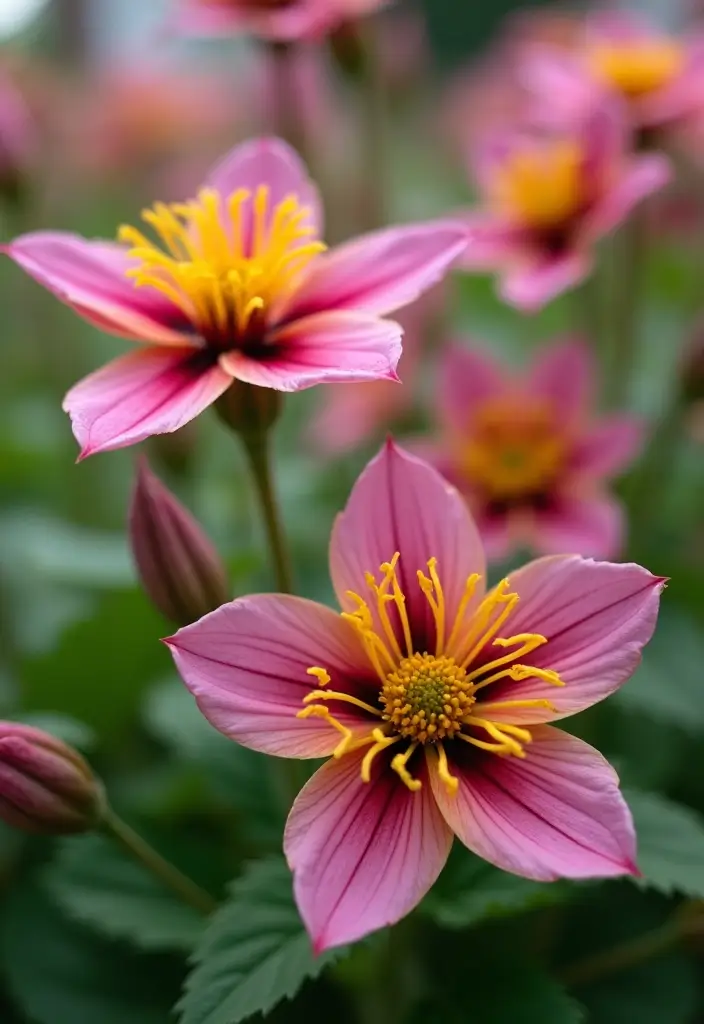
Columbines are enchanting perennials that thrive in shaded gardens, showcasing delicate, spurred flowers in a range of colors. Blooming in late spring, these plants can handle various soil types and are perfect for bringing charm to your garden. To ensure they flourish, consider using organic flower fertilizer like Espoma Organic Flower-Tone, which provides essential nutrients for your flowers, helping to boost blooms and overall health.
Additionally, since Columbines self-seed easily, allow some blooms to go to seed for natural expansion. And to enhance your garden’s appeal to wildlife, installing a hummingbird feeder can create a delightful atmosphere. The unique flower shape of Columbines attracts these charming birds, making your garden a wildlife haven.
Don’t forget to protect your hands while gardening! A pair of gardening gloves can provide comfort and grip, allowing you to work more efficiently in your shaded garden. Bring your space to life with Columbines and the right tools to ensure a thriving, colorful garden year-round!
17. Wood Anemone: Spring Surprise
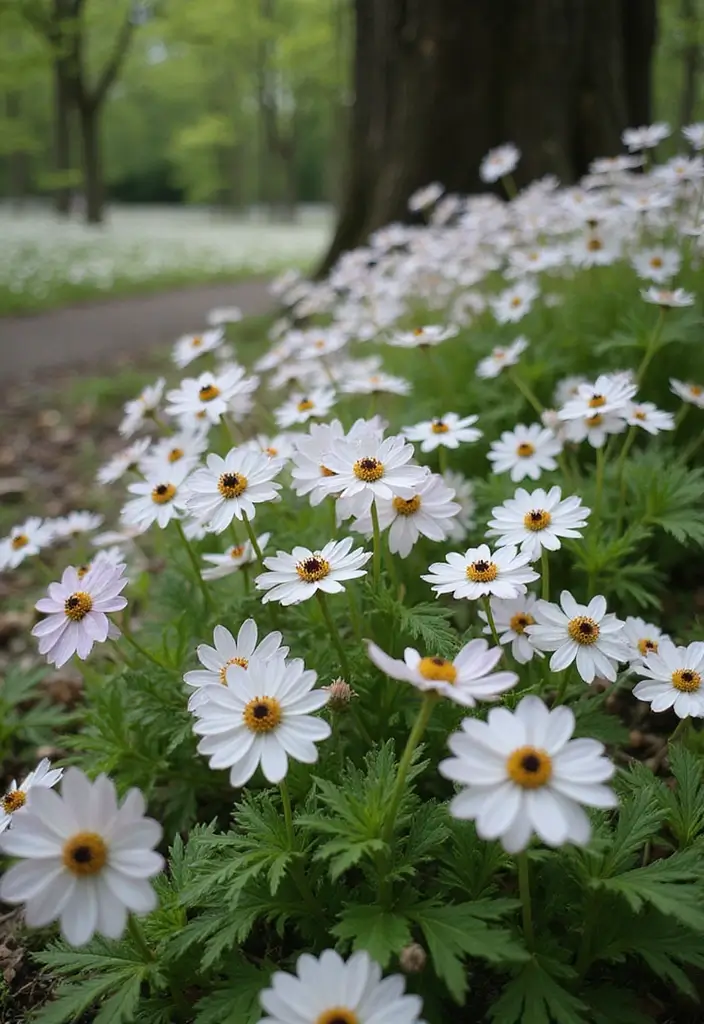
Wood anemone is a charming perennial that carpets the forest floor with delicate, star-like flowers in early spring. These resilient plants thrive in shady spots and can quickly spread to create a stunning display. To ensure they flourish, it’s essential to monitor the soil conditions. Using a garden soil moisture meter can help you determine when it’s time to water, ensuring the wood anemones have the well-drained, moist soil they prefer. Additionally, mulching can be beneficial for these plants. Consider applying mulch for garden beds to retain moisture and suppress weeds around your wood anemone. They also make great companions for other spring bloomers, enhancing your garden’s overall appeal. The beauty of wood anemones lies in their ability to naturalize, coming back year after year with little maintenance, making them a perfect addition to any garden. For those looking to expand their garden’s diversity, you might want to explore organic perennial flower seeds, which include a variety of options that can complement the spring display.
18. Anemone: Late Blooming Beauty
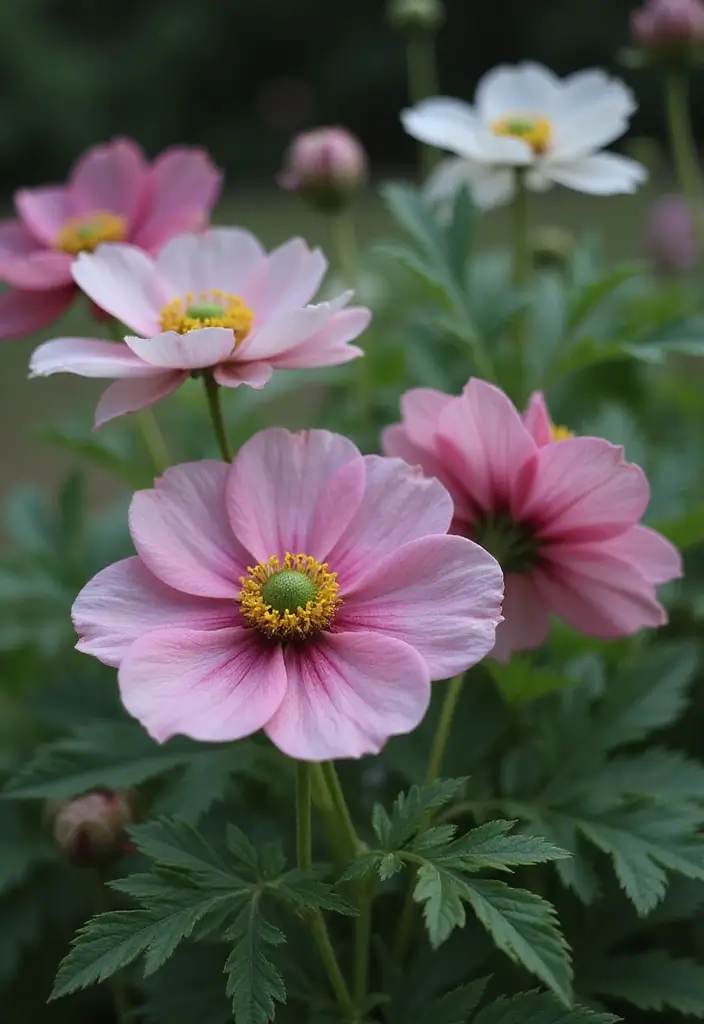
Japanese anemones bloom late in the season, bringing vibrant colors to the shaded areas of your garden when many plants are fading. Their tall stems adorned with white, pink, or purple blooms add elegance and movement. To ensure your anemones thrive, consider checking your soil moisture with an soil moisture meter. This handy tool will help you monitor the moisture levels, ensuring that these plants receive regular watering during dry spells, which is crucial for their health.
Additionally, using organic mulch around your anemones can help retain moisture in the soil while also preventing weeds from taking over. They prefer well-drained soil, and mulch can aid in maintaining those ideal conditions. Remember, these plants thrive in groups, creating a beautiful wave of color and texture as they sway in the breeze, so plant them in clusters for the best effect.
19. Geranium: Colorful Ground Cover
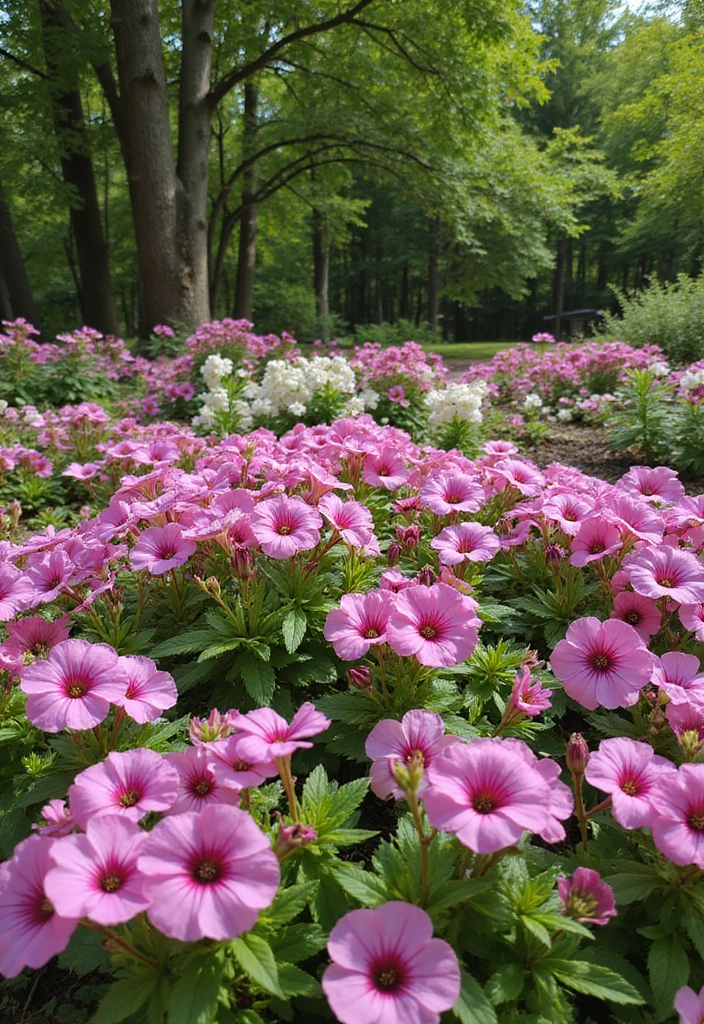
Cranesbill geraniums are fantastic for shaded garden areas, providing ground cover with delicate flowers. Blooming from spring through fall, these hardy perennials come in various colors such as blue, pink, and white. They require minimal maintenance and can tolerate dry soil once established, making them an excellent choice for low-effort gardening.
To ensure your geraniums thrive, consider using a garden soil moisture meter. This handy tool will help you monitor the moisture levels in your soil, ensuring your geraniums receive just the right amount of water, especially during drier seasons.
Additionally, geraniums are known to act as a natural pest deterrent, keeping your garden healthy while still looking beautiful. For extra protection against common pests, you might want to try an organic pest control spray made from peppermint oil. It’s a natural solution that can keep spiders, ants, and more at bay without harming your plants.
If you’re looking to enhance your garden further, consider adding variety with the perennial flower seeds assortment, which includes 18 different non-GMO flower varieties. This can complement your geraniums beautifully, creating a vibrant and pollinator-friendly garden space.
20. Creeping Jenny: Golden Glow
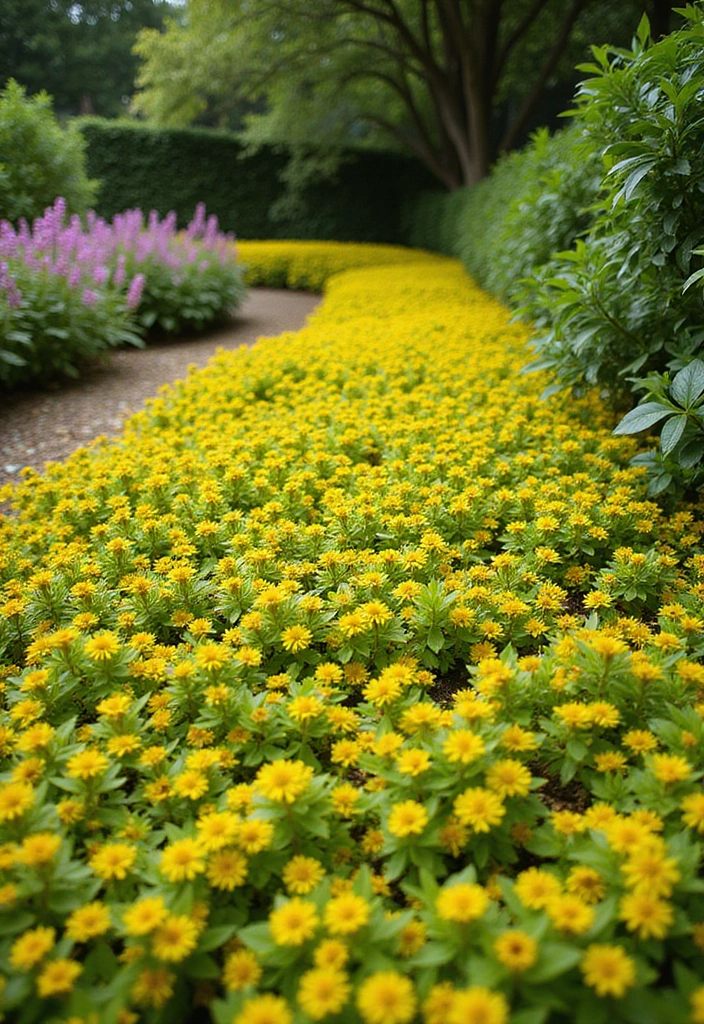
Creeping Jenny is a stunning low-growing perennial that thrives in shade and displays bright yellow-green foliage. In spring, it blooms with small yellow flowers that perfectly contrast its vibrant leaves. This plant is ideal for covering shady spots and can tolerate wet conditions, making it a great choice for those tricky areas in your garden. To ensure your Creeping Jenny remains healthy and vibrant, consider using organic fertilizer for perennials. This product helps provide essential nutrients that support strong growth, enhancing the beauty of your garden.
Additionally, as Creeping Jenny can be quite vigorous, it’s important to monitor its spread. A garden soil moisture meter can be a handy tool to help you gauge when to water your plants, ensuring they thrive without becoming overwhelming. Plus, the foliage turns a beautiful golden-orange in fall, adding a vibrant touch to your garden as the seasons change. For the best results, consider using Creeping Jenny live plants to create a stunning accent in your landscape.
21. Catmint: Aromatic and Hardy
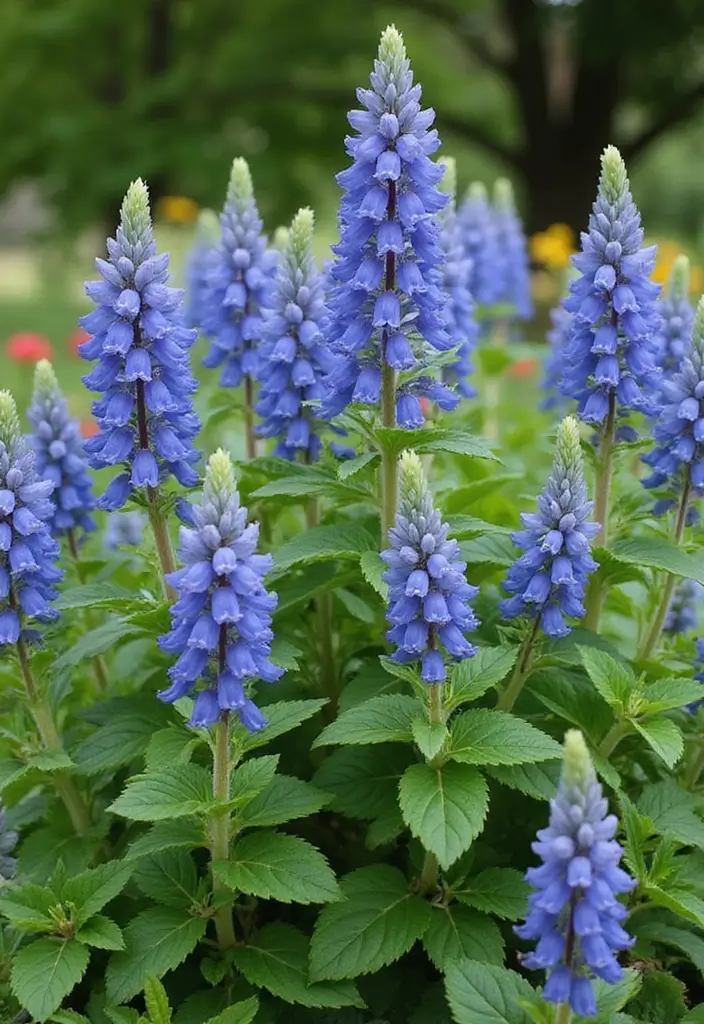
While catmint loves the sun, some varieties are surprisingly tolerant of partial shade. This aromatic perennial produces blue flowers and can bloom multiple times throughout the summer. To ensure your catmint thrives, consider using Espoma Organic Flower-Tone, a natural and organic plant food that provides balanced nutrients, supporting vibrant growth and abundant blooms for your catmint. It’s especially beneficial for perennials, helping them flourish year after year.
Catmint attracts pollinators and can thrive in various soil types. Don’t forget to deadhead spent blooms for a more extended flowering period. Additionally, you can start your catmint journey with catmint seeds, which are non-GMO and untreated, ensuring you’re planting a resilient and hardy variety.
Unique Insight: Catmint’s fragrant foliage deters some pests, making it an excellent choice for low-maintenance gardening.
Embrace the beauty of low-maintenance gardening! With catmint’s enchanting blue blooms and fragrant foliage, you can attract pollinators while keeping pests at bay – all in partial shade!
22. Sansevieria: Stylish and Unique
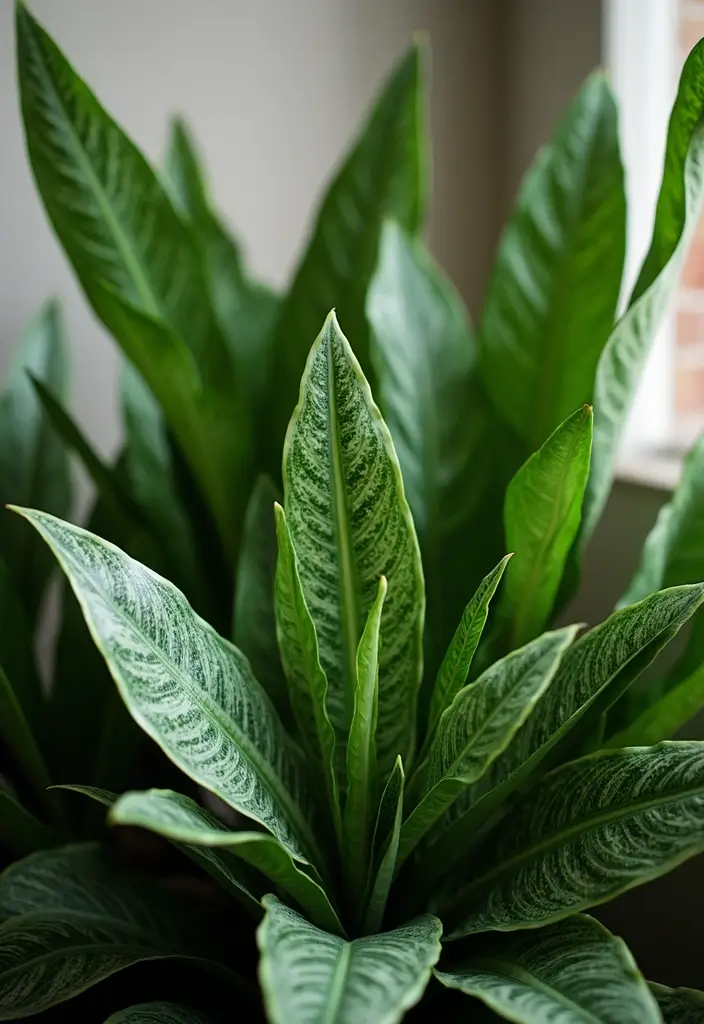
Believe it or not, snake plants (Sansevieria) can also thrive in low-light conditions, making them perfect for shaded corners. Known for their striking, upright leaves, they come in various patterns and colors. To keep your snake plant healthy, consider the snake plant (Sansevieria) indoor plant, which arrives fully rooted in potting soil and ready to enhance your space with its unique beauty.
Remember to water sparingly; they prefer to dry out between waterings. A plant care watering can can make this task easier, especially with its long spout designed for precise watering.
Additionally, snake plants are known for their air-purifying qualities, adding both beauty and health benefits to your space. To further support their growth, you might want to use air purifying plant fertilizer. This liquid plant food is suitable for snake plants and helps ensure they thrive, making your home even more vibrant and healthy.
23. Ajuga: Ground Cover Marvel
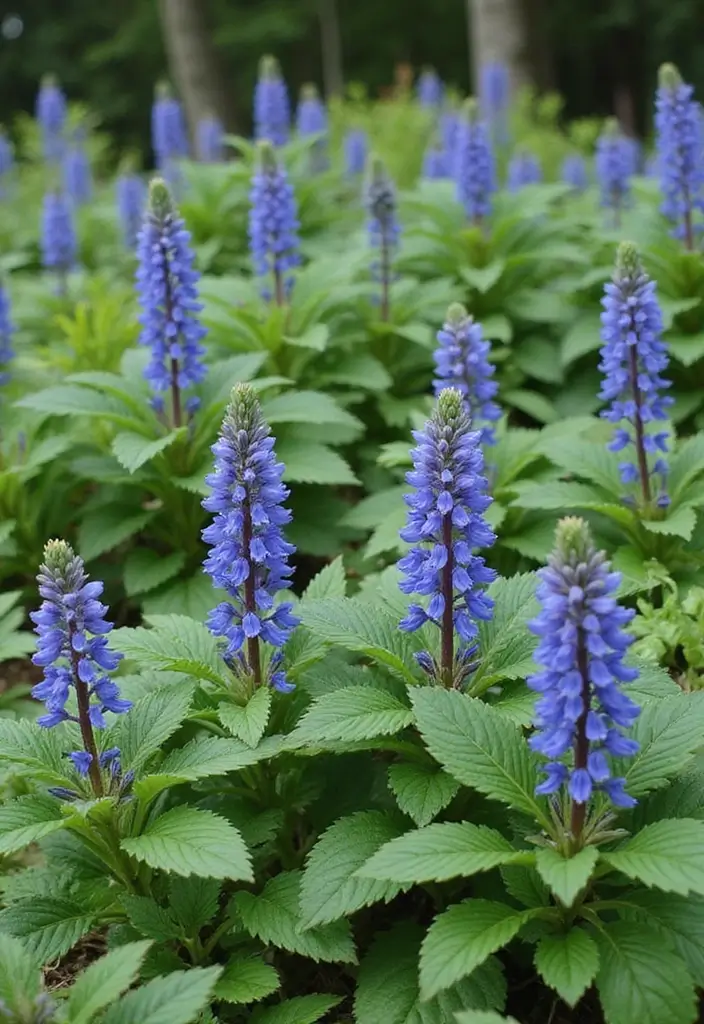
Ajuga, or bugleweed, is a low-growing perennial that thrives in shade and produces lovely spikes of blue flowers. This hardy plant is excellent for ground cover and spreads quickly, filling in bare spots. To ensure your ajuga flourishes, consider using a garden soil test kit. This kit provides complete and accurate nutrient and pH analysis, helping you tailor your soil to meet ajuga’s needs.
Additionally, applying organic mulch can help retain moisture and suppress weeds around your ajuga, allowing it to thrive even in varying soil conditions.
To promote healthy growth, don’t forget to feed your plants. A quality perennial plant food like Miracle-Gro can provide the essential nutrients your ajuga needs, boosting its vigor and flower production.
Unique Insight: Ajuga’s foliage can take on beautiful shades of burgundy in fall, creating additional seasonal interest. With the right care, your ajuga can be a stunning addition to your garden year-round.
24. Yarrow: Drought-Resistant Wonder
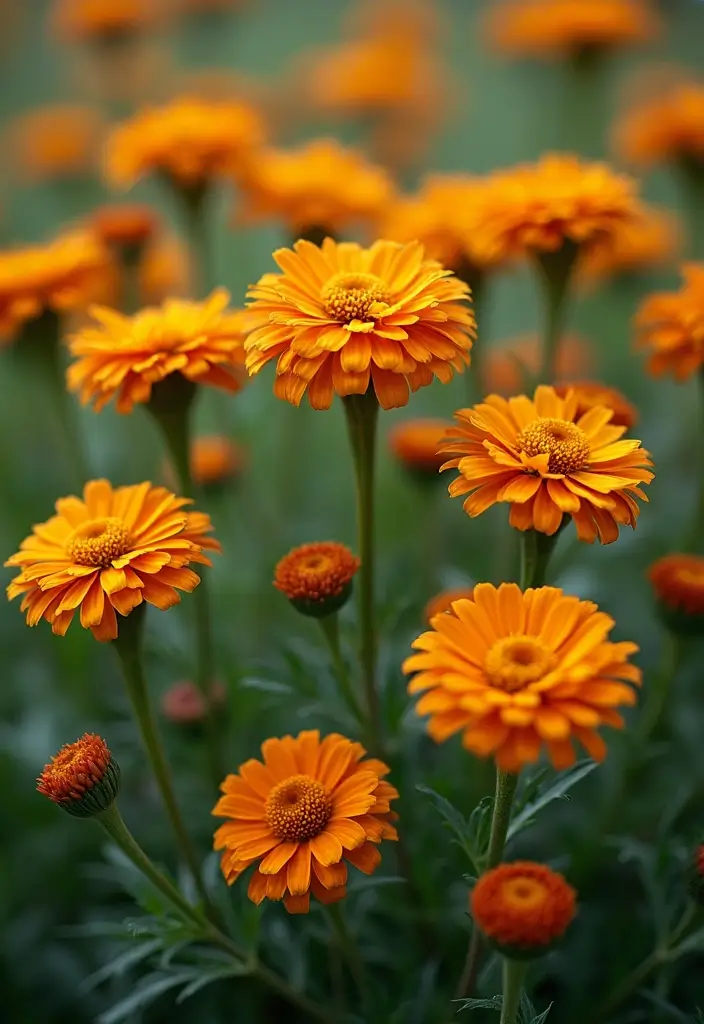
Yarrow is a drought-resistant perennial that can thrive in various conditions, including partial shade. Known for its flat-topped clusters of flowers that bloom in summer, it attracts butterflies and beneficial insects. To encourage continuous blooming throughout the season, it’s important to deadhead your yarrow regularly. For this task, having a reliable pair of garden pruning shears can be incredibly helpful. These Fiskars bypass pruning shears have a sharp, rust-resistant steel blade that makes clipping easy and efficient.
To ensure your yarrow grows healthy and vibrant, consider using organic fertilizer for perennials. The Espoma Organic Plant-Tone is an all-purpose plant food that provides essential nutrients for flowers, ensuring that your garden flourishes.
Additionally, planting yarrow from seeds can be a rewarding experience. You can find yarrow seeds that are non-GMO and come with instructions to help you cultivate this beautiful and medicinal herb successfully. With these products, you not only enhance the beauty of your garden but also add a valuable plant known for its medicinal properties.
25. Lady’s Mantle: Soft Textures
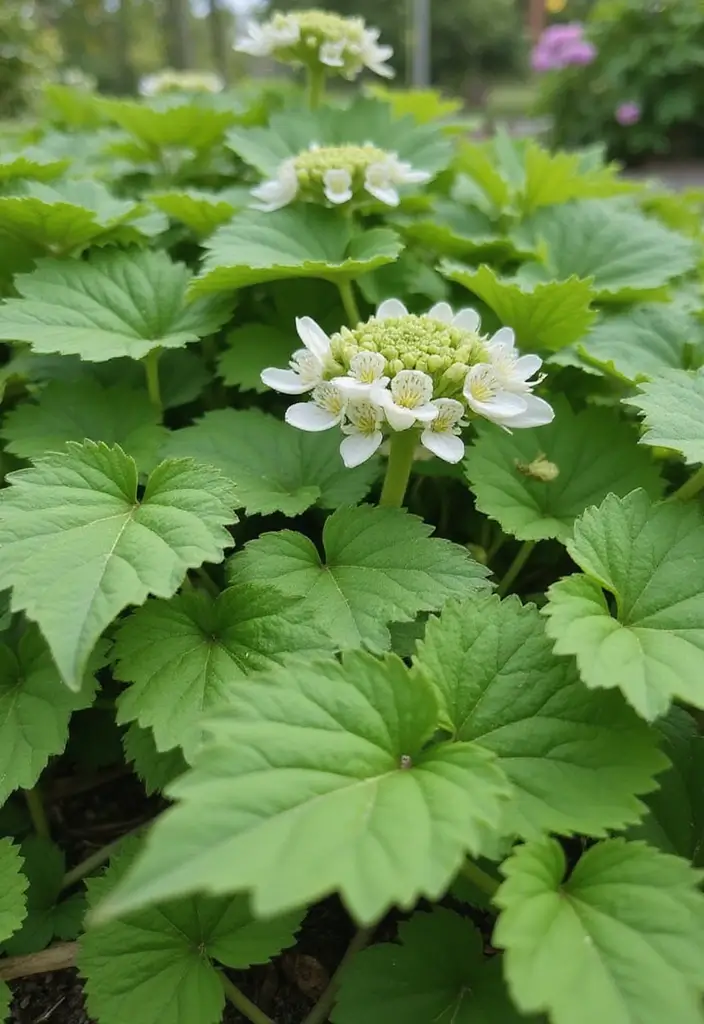
Lady’s mantle is a charming perennial known for its soft, rounded leaves and tiny yellow flowers. This plant thrives in partial shade and is excellent for adding a textured look to your garden. Its foliage collects dew in the mornings, creating a beautiful, shimmering effect. To successfully cultivate lady’s mantle, consider using high-quality soil like Michigan Peat Compost and Manure Blend, which enriches the ground with essential nutrients and minerals, ensuring your plants thrive.
Additionally, the Organic Lady’s Mantle Seeds can help you propagate this lovely perennial, offering a versatile and low-maintenance option for your garden. As you plant, having a reliable tool like the Fiskars Ergo Cultivator will make digging, aerating soil, and weeding much easier, allowing you to create the perfect space for your lady’s mantle to flourish.
Remember to let it spread for natural ground cover. Also, a unique insight is that the leaves of lady’s mantle can be harvested and used for herbal remedies, adding a practical element to your garden.
Conclusion: Your Colorful Shade Oasis Awaits
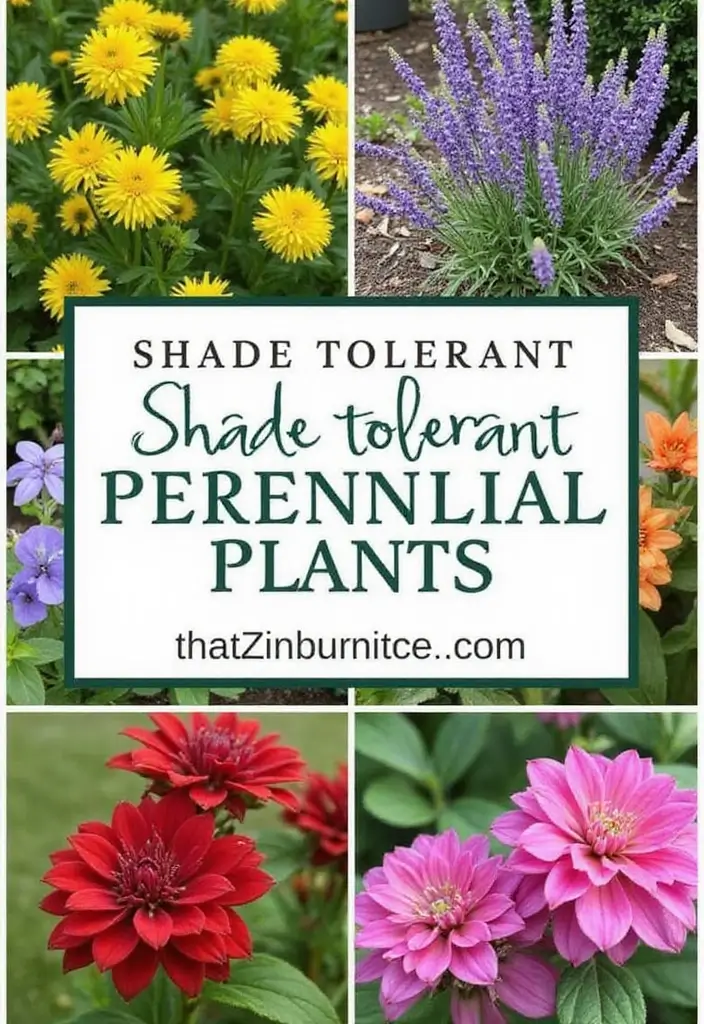
With these 25 perennial garden ideas, your shaded areas can come to life with color and elegance. Each of these plants adds unique charm and beauty to your garden and often requires minimal maintenance. By selecting the right combination of these varieties, you can create a stunning space that thrives year-round. Don’t forget to plan your garden design accordingly, considering the seasonal blooms and textures that will keep your oasis vibrant and inviting.
Note: We aim to provide accurate product links, but some may occasionally expire or become unavailable. If this happens, please search directly on Amazon for the product or a suitable alternative.
This post contains Amazon affiliate links, meaning I may earn a small commission if you purchase through my links, at no extra cost to you.
Frequently Asked Questions
What are the best shade-tolerant perennial plants for my garden?
If you’re looking to brighten up your shady areas, consider adding Hostas, Astilbe, and Coral Bells. These perennials not only thrive in low light but also offer stunning foliage and blooms that can add year-round color to your garden.
Each of these plants brings its unique charm, from the broad leaves of Hostas to the feathery plumes of Astilbe, making them excellent choices for vibrant shade gardens.
How can I design a low-maintenance perennial garden?
Designing a low-maintenance perennial garden starts with choosing the right plants, such as Japanese Forest Grass and Epimedium. These plants are hardy and require minimal upkeep.
Incorporate a mix of foliage and flowering perennials that bloom at different times throughout the year for continuous color without constant attention. Also, consider mulching to suppress weeds and retain moisture, simplifying your gardening efforts!
Which perennials provide the most color throughout the seasons?
For a garden that dazzles with color all year, mix Bleeding Heart, Japanese Anemone, and Columbine. These perennials offer vibrant blooms in spring and summer, keeping your garden lively.
Consider adding Yarrow and Astilbe for late summer and fall interest, ensuring your garden is a feast for the eyes from early spring to late fall!
How do I ensure my shade garden stays healthy and vibrant?
To keep your shade garden thriving, select perennial plants suited to your specific light conditions and soil type. Regularly check for moisture levels since shade can sometimes lead to overly damp soil.
Incorporate organic matter into the soil to improve drainage and nutrients, and be sure to prune dead or damaged foliage to encourage healthy growth. This way, your garden remains lush and vibrant!
Can I mix different types of perennials in my shade garden?
Absolutely! Mixing different types of perennials can create a stunning visual impact in your shade garden. Combine various textures, colors, and bloom times to keep the space interesting year-round.
For example, pair the soft foliage of Ferns with the colorful flowers of Coral Bells and Toad Lilies for a dynamic look that also attracts pollinators. Just ensure that all plants thrive in similar light and soil conditions for the best results!
Related Topics

